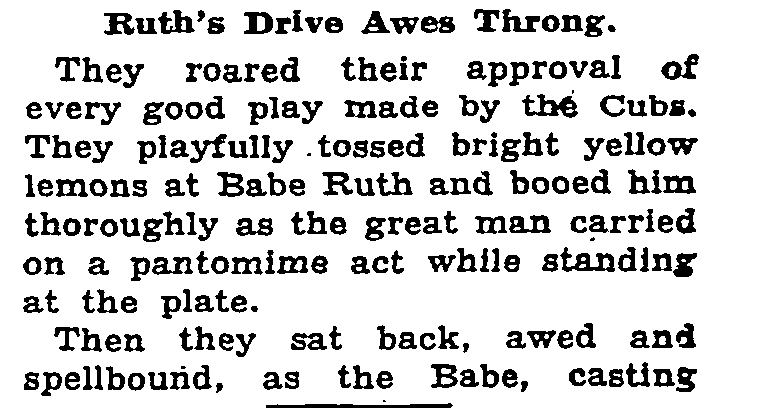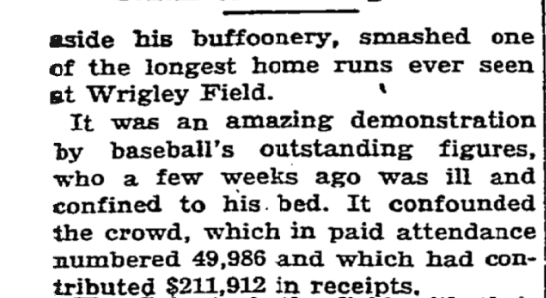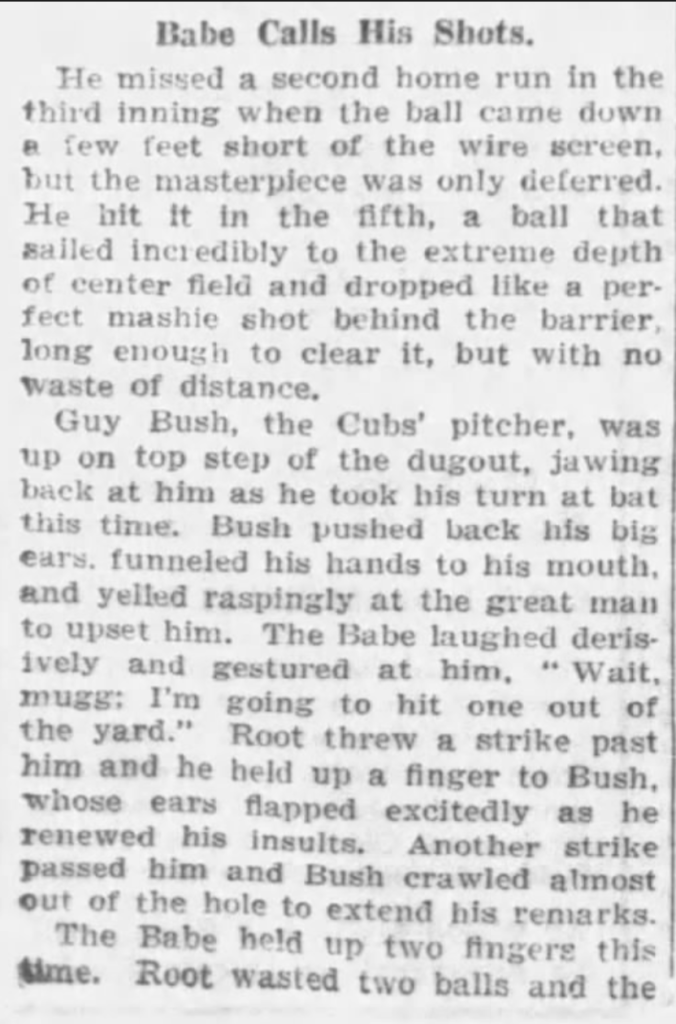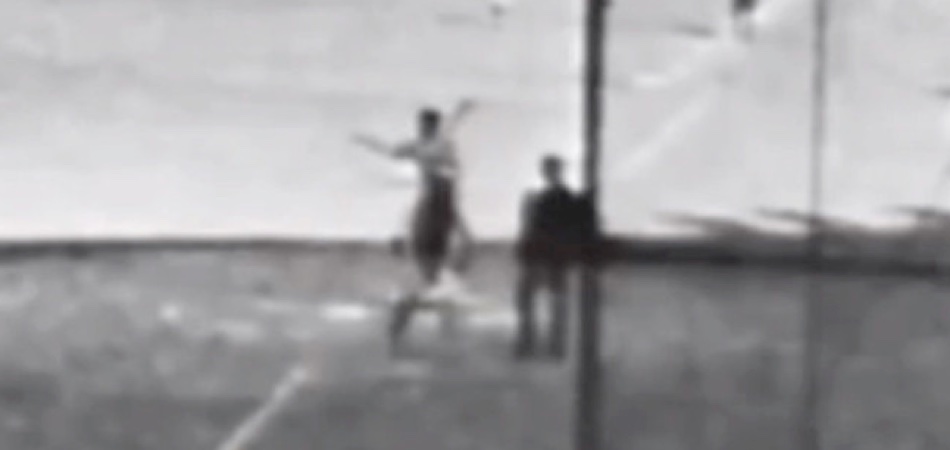Good morning, all. Today begins a new era of Apocalypse Sports, with blog posts now running on Monday, Wednesday, and Friday, and podcasts Tuesday and Thursday. Rather than any kind of contemporary analysis, the blog posts will now focus on some bit of sports history, or a compelling incident, or a certain personality, or…you get the gist. The Tuesday podcast will be an audio version of the same, while the Thursday podcast will continue the longform interview format used to date. Enjoy!
*
The most interesting thing about mythmaking, in sports and otherwise, is not how it happens, but why. I thought about this a lot while The Last Shot, ESPN’S Jordan documentary, was airing. As much as I enjoyed all ten episodes, I still believe it was a project designed to burnish the myth of Michael Jordan, rather than examine it, and it was the perfect confluence of subject and moment. Jordan is that rare figure who lends himself to myth; by virtue of his great talent and even greater competitive streak, his on-court career is a story of endless triumph, of constantly overcoming his enemies and soaring to greater and greater heights. He was a kind of pathological strongman, but in an arena, sports, that we could enjoy without guilt. In real life, of course, he was subject to the same vagaries of fate and chance as any human being, but uniquely among athletes, it’s possible to craft his story as a legend. He may not have been superhuman, but he was definitely close enough to fake it.
The timing was every bit as good as the content. It aired at the start of the coronavirus pandemic, and it doesn’t take a genius to see how perfectly fitted a story of certainty and greatness, whose end was already known, was just what we needed when life and sport looked incredibly tenuous. For the same reason that people often find religious faith in times of great insecurity and danger, some of us used the Jordan legend as a crutch to get us through the first days of the shutdown. We crave certainty at the best of times, and we seek it out like a dying man seeks water when our foundations shattered. The appeal was never stronger.
Do we need myths, on some psychological level? Are they even beneficial, or do they create unrealistic views of the world that keep us from seeing the truth? Those questions are interesting, but what matters more is how compelling these stories are, how irresistible, and what that says about our nature.
*
It’s harder to maintain a myth today, deluged as we are by media. When Babe Ruth played for the New York Yankees, it wasn’t quite so tough. Which brings us to the “called shot.”
Most baseball fans know the basics: At some point in his career, in the middle of an at-bat, Babe Ruth pointed toward the fences and predicted that he’d hit a home run. On the next pitch, it happened, and a myth was born.
The specific details might be less accessible, even to a fan—they were for me. I didn’t realize, for instance, that the called shot happened in a World Series. (Or maybe I’d just forgotten.) Nor did I realize Ruth was so old.
It happened on Oct. 1, 1932, at Wrigley Field. Ruth was 37. It was Game Three of the World Series, which the Yankees led 2-0, and tensions were high. Ed Sherman of the Chicago Tribune wrote a book about it, and you can read the details in this Post review. The short version is that a Yankee veteran named Mark Koenig had been signed by the Cubs in August, and the team voted before the World Series that he’d receive only a half-share of World Series earnings—a bonus that meant a lot, in the days before massive salaries. His former Yankee teammates were furious on his behalf, and when Ruth first saw the Cubs before Game One at Yankee Stadium, he had some choice words, calling them “a bunch of cheapskates, nickel-nursers and misers.” (I really hope that quote is legitimate—it’s poetic in its vitriol.)
In response, the Cubs mocked him for his age, and struck a low blow by pointing out that the Yankees, who had passed Ruth over twice in their hunt for a manger, considered him too stupid to lead the team. When Ruth and his wife got off their train in Chicago before Game Three, they were actually spat on by a group of women.
You get the picture: everybody was pissed off at everybody else. In Game Three, with a home run already under his belt and the score tied at 4-4, Ruth came up in the fifth inning against Charley Root and worked the count to 2-2.
That’s when he did it: He pointed to center field, called his shot, and hit the next pitch exactly where he’d predicted.
*
The problem, as you’ve probably guessed, is that it’s simply not true. I could compile the evidence, tease it out, and build the case slowly, but why bother? We might as well just drop the big bomb first. The very next year, before the start of the season, Ruth was asked by a Chicago reporter if it actually happened, and he debunked it in no uncertain terms:
“Hell no. Only a damn fool would have done a thing like that. There was a lot of pretty rough ribbing going on . . . there was that second strike, and they let me have it again. So I held up that finger . . . and I said I still have one left. Now, kid, you know damn well I wasn’t pointing anywhere. If I had done that, Root would have stuck the ball in my ear. I never knew anybody who could tell you ahead of time where he was going to hit a baseball.”
Oops.
*
So why did it become a story, and why does it persist? Partly because of the initial media reaction. In his book, Sherman pieces together the chronology, noting that one reporter shouted “he hit it exactly where he pointed!”, which started a cascading chain of events that led to a New York World-Telegram headline reading “Ruth Calls Shot As He Puts Homer No. 2 In Side Pocket.” Interestingly, the New York Times—which, incidentally, noted that FDR, then just a presidential candidate, was on hand to throw out the first pitch—made no mention of a called shot, as you see here:



Through the magic of Newspapers.com, we can also read the Chicago Tribune account, which doesn’t mention a called shot in the gamer:


However, in a separate column, there’s a description of a “called shot”:


Quick side note, one of the chief pleasures in researching this story is learning the sheer amount of shit-talking that went on. Look at this exchange, also from a Tribune report:

As you see, even in that second description, there’s no mention of Ruth pointing to center field. He basically just seems to be clowning around, and enjoying every minute of kicking the Cubs’ ass.
As for Root, the pitcher, he was incensed at the idea. “Ruth did not point at the fence before he swung,” he said. “If he had made a gesture like that, well, anybody who knows me knows that Ruth would have ended up on his ass. The legend didn’t start until later…it never occurred to me then that the people in the stands would think he had been pointing at the bleachers … Maybe I had a smug grin on my face after the second strike. Babe stepped out of the box, pointed his finger in my direction and yelled, ‘You still need one more, kid.’”
*
In the aftermath, a number of Yankee players verified the “called shot” story, including Lou Gehrig. Guy Bush, Ruth’s chief antagonist, also backed it up. Other fans at the game, including future Supreme Court justice John Paul Stevens and Lincoln Landis, son of MLB commissioner Kennesaw Mountain Landis, for years stuck to the story that it really happened. Eventually, though, doubt crept into every account, and even Joe Williams, the writer who originally started the called shot myth, recanted, saying “it was just as easy to believe Ruth had actually called the shot as not, and it made a wonderful story, so the press box went along with it.”
Not surprisingly, Ruth started taking part in the myth. He had told his teammates that he was just razzing Root and Bush, but before long—aside from the admission to Totten the next year—he was playing along and then some. There’s an account by Grantland Rice of him telling the story to the wife of Walter Lippman, a newspaper columnist, which is worth re-printing here for the sheer, delightful vulgarity (originally from Leigh Montville’s The Big Bam):

Fucken crumbums!
Now, this account was written years later in Rice’s autobiography, and it is worth knowing that like almost every famous sportswriter of his time, Rice pretty much lied and exaggerated about anything and everything. But as Sherman notes in his book, Ruth told the story again in a 1937 short film, though he got some of the details wrong, such as his claim that the count was 0-2 (it was 2-2).
As far as mythmaking went, the Called Shot soon had its best ally in Babe Ruth.
*
There are more than a few stories like this in sports, though the Called Shot is definitely the most famous. One that came to mind right away was the story of Larry Bird and Chuck Person. During a Celtics-Pacers game on Christmas Day, Bird supposedly told Person before the game that he had a present for him, and during the game, he shot a three by the Pacers bench, turned to Person while the ball was still in the air, and said, “merry fucking Christmas.” Of course, the shot went in.
Rangers great Mark Messier once guaranteed victory in Game Six of the 1994 eastern conference finals against the New Jersey Devils. Jordan, on many occasions, predicted shame and humiliation for his opponents before delivering exactly that.
From the Called Shot on, these moments speaking to a bone-deep desire in all of us. We want to be in control, to be successful, to be such rocks of humanity that we can even telegraph our victories ahead of time. I’ve heard a story (probably apocryphal) that in pre-modern times, warriors who wore beards into battle were seen as courageous and fearsome, because in hand-to-hand combat a beard was such a vulnerability. By growing a beard anyway, the warrior was essentially telling the enemy he was so strong that he didn’t care. That’s the same spirit behind the Called Shot.
Life teaches us differently—we’re lucky if we can stay afloat—and for all but the delusional, it deflates each mythic longing with the simple passage of time. But life can’t deprive us of stories. When it comes to the yearning for mastery, for absolute conviction, Ruth’s called shot is perfect. Even if it’s not true.
*
As always, please feel free to forward this post to anyone you think might enjoy it. If they read for a couple days and don’t become subscribers, you can cut them off without mercy. If you’re reading this as a non-subscriber and want to get locked content, including two podcasts each week, you can subscribe here.


